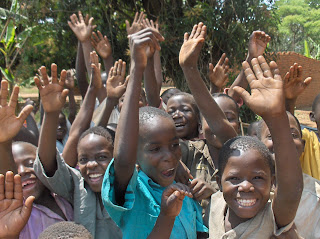Sunday morning started with me discovering a dead rat in our kitchen sink. BLEAH. I’m having difficulty finding the right words to describe just how horribly affronted I was that this unwelcome rodent had the audacity to crawl into our sink and die there…anyway, at least the thing is finally dead. We have Natalie to thank for that one; she purchased a new rat poison by the name of “Rat Tears.” The peanut butter flavor variety was highly effective, I suppose.
So about halfway through my visit here in Uganda, I finally got a chance to sit down with one of the team leaders for my cultural orientation. In a way, it’s helpful to wait a while before experiencing this orientation. This way, you get to observe and process things, and also hear other people’s stories. These events suddenly make much more sense in the light of the information you glean during the orientation.
After two months of living here, I thought I was starting to get the hang of how things worked. I mean, obviously there are differences between an American and a Ugandan, but we’re still people. Surely we have some common ground; the same physical need for food and water, the need to be loved and accepted, a desire to belong, etc. About four minutes into the cultural orientation, my view of American/Western culture and East African culture was blown wide open.
Let’s start with communication. First of all, there are dozens of different languages spoken in Uganda. Of all of these languages, I know about three useful phrases in Swahili, which is spoken more in Kenya than Uganda. I was given a sheet with common phrases in six of the more commonly spoken languages here in Mbale. Take a look at Luganda:
Wasuze otya, Ssebo? (How did you sleep, sir?)
Osiibye otya, Nyabo? (How is the day, madam?)
Nsanyuse okukulaba (I’m happy to see you)
When I attempt to muddle my way through these greetings, it sounds something like “Waaaah-sooo-zay oat-yah, saaaaay-boh?” When I asked for some help from friends at choir practice, their greeting sounds like, “Wasoozotiasaybo?” I don’t know where that “e” at the end of “wasuze” went, but apparently it’s not essential for a proper greeting. This makes me very appreciative of all the Ugandans who have learned to speak English.
Now, let’s talk about style of communication. Think for just a minute of what makes a “good communicator” from a Western mindset. I think of someone who can clearly state their opinion. They don’t confuse their listener, and they are direct in their requests, sometimes taking great pains to ensure they are properly understood. They are also succinct; I tend to be easily annoyed by individuals who talk and talk and talk and take too long to get to the point. In African culture, direct communication is viewed as brash, rude, and detrimental to the relationship of the person you are communicating with. All demands and requests are “hidden” in indirect communication. Africans tend to talk around the subject at hand; it is the responsibility of the listener to decode the message and decipher the true meaning behind the speaker’s words. Indirect communication may drive Westerners crazy, but for Africans, it is a high art form.
Part of the reason behind all this indirect communication is the different ways Westerners and Africans view relationships. Westerners tend to value truth above relationships; we want to know the truth, no matter how bad it hurts. Africans value the appearance of the relationship. If the truth is going to upset a friend, they will lie to preserve that relationship. For example, if a worker is raking leaves outside the house and accidentally breaks a window pane with the end of their rake. If you storm outside and yell, “What did you do?!,” they will lie to you. They think you are angry, and they don’t want you to be angry at them for what happened- that would damage the relationship. Instead, they may tell you that a kid threw a rock at your window and broke it, but they chased them away. To an African mind, telling the truth means upsetting you and threatening the status of your relationship. They lie preserves the appearance of a happy relationship.
Now think about how just these two differences affect communication between a Westerner and an African. (And these are just two differences! There are so many more!) The amount of lies and omitted information make it nearly impossible for the newbie missionary to fully understand what is going on. You must constantly evaluate what “cultural lenses” you are using the view the situation, because they are most certainly going to be different from the cultural lenses of an African. Even after just these two examples of culture differences, I hope you can begin to grasp what a difficult task working as a missionary here in Uganda can be.

On a lighter note, I’ve included a wonderful letter the teachers received from one of our youngest pupils. Annalise wrote us a letter (delivered to us in the form of a paper airplane) during our Wednesday night devo after she had received her report card. I guess she thought it would be appropriate for her to return the favor and report on the school before her family took a few days off for vacation.
Also, the additional picture is of the waterfall at the top of Mt. Wanale. Emily and I climbed Wanale for the second time this week. We climbed it in a much shorter span of time and were considerably less sore than after last week's hike!






















